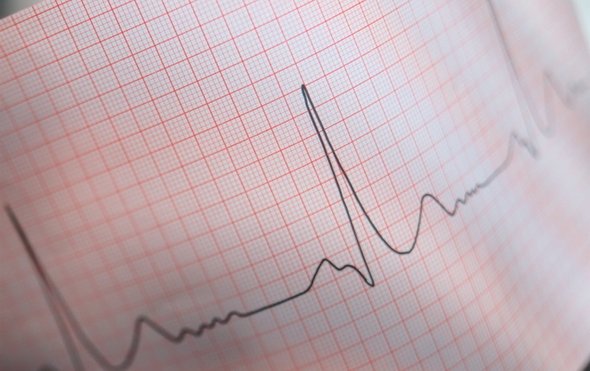(单词翻译:单击)
听力文本
This is Scientific American — 60-Second Science. I'm Christopher Intagliata.
(ECG sound) That beeping sound is the normal beating of a heart.
(ECG fast sound) But here's what the same heart sounds like, during a bout of ventricular tachycardia, or VT... the racing beats are caused by an electrical short circuit in the muscle. In a moment, a defibrillator is going to zap the heart, to return it to a slow and steady pace.
The root cause of VT? "So the villain inside the heart is almost always a scar from a prior injury." Phillip Cuculich, a cardiac electrophysiologist at Washington University in Saint Louis. "Most commonly that's a prior heart attack or sometimes leftover scar from an infection that somebody might have, or an inflammatory disease someone might have."
That arrhythmia can be treated with drugs, or surgery, too: by inserting catheters up through the leg into the beating heart, and blasting the troublemaking scar tissue with heat. That kills the scar cells, and can coax the heart back to a normal rhythm.
But now Cuculich and his colleague Clifford Robinson are trying to achieve the heat treatment's effect noninvasively, by blasting those tiny scarred patches of the heart with high-dose radiation... the kind used to destroy brain and lung tumors.
"You might say that destroying heart doesn't sound appealing, and it doesn't sound like that's a good thing." But in a limited study of five patients who'd run out of other options, the treatment dramatically cut cases of arrhythmia. Before treatment, they collectively suffered more than 6500 bouts of arrhythmia in just three months. In the six weeks after treatment – the incidents plummeted to only about 700. And in the following year the group experienced only four arrhythmias, collectively...a 99.9 percent reduction. The method, which Cuculich and Robinson have a patent pending on, is described in The New England Journal of Medicine.

The treatment does have advantages: it's just 15 minutes, compared to 6-8 hours on an operating table. It seems at least as effective as the surgical treatment. And though a typical session of this radiation can cost tens of thousands of dollars, the doctors say that might still be cheaper than surgery and the resulting hospital stay.
But there are uncertainties, like whether the radiation may contribute to cancer later in life, or damage nearby structures. And one patient had a fatal stroke three weeks after treatment...though it's unclear if the treatment had any connection. Robinson says that the technique might work like surgery, by damaging or killing scar cells, but the mechanism has not been proven.
"This needs to be investigated in multiple levels, in what we refer to the preclinical environment, so looking at cells or animals. But this also could be investigated further in patients, by understanding what's happening using imaging, after the patient received their treatment. Or looking at how the signals of the heart change after treatment as well."
But if this radiation method proves safe and effective, it might be a simpler strategy...to help the heart regain its rhythm.
Thanks for listening for Scientific American — 60-Second Science. I'm Christopher Intagliata.
参考译文
这里是科学美国人——60秒科学。我是克里斯托弗·因塔利亚塔。
(心电图的声音)这种“哔哔声”是心脏正常跳动的声音。
(心电图的声音)而这是同一颗心脏的声音,在室性心动过速(简称VT)发作的情况下,肌肉中的短路会导致心跳加速。除颤器可以立刻震击心脏,使心跳恢复到缓慢且平稳的节奏。
室性心动过速的根本原因是什么?“心脏会出现这种问题的罪魁祸首几乎总是过去受伤所留下的伤疤。”华盛顿大学圣路易斯分校的心脏电生理学家菲利普·库库里奇说到。“最常见的是,先前的心脏病发作或有时某人可能患感染或是某种炎症所留下的伤疤。”
心律不齐可以通过药物或手术治疗:将导管通过支架插入跳动的心脏中,用高温将有问题的疤痕组织烧掉。这样做可以杀死疤痕细胞,使心脏恢复正常节奏。
但是现在,库库里奇和同事克利福德·罗宾逊试图通过使用高剂量辐射来清除掉心脏中那些小疤痕,以此来实现热治疗的非侵入性影响,这种方法还可以用来消灭脑瘤和肺肿瘤。
“你可能会说,摧毁心脏组织听起来并不吸引人,而且听起来也不是什么好事。”但是一个对没有其他选择的5名患者进行的有限研究发现,这种治疗方法大大减少了心律不齐的发生。在治疗之前,他们在短短3个月的时间里共遭受了6500多次心律不齐。在治疗6周后,发病数量骤减至只有约700次。而在接下来的一年时间里,这些人只发生过4次心率不齐,整体来说,发病率减少了99.9%。库库里奇和罗宾逊正在为这一方法申请专利,《新英格兰医学杂志》对该方法进行了具体描述。
这种治疗方法的优点是:只需15分钟就能见效,而做手术需要6到8个小时。至少这种方法看起来和手术治疗一样有效。虽然这种放射疗程通常要花费数万美元,但是医生们表示,这可能仍比手术费用低,而且还能降低住院率。
但是,还有一些不确定性,比如这种放射疗法是否会在之后导致癌症,或对邻近组织造成损害。一位患者在接受治疗3周后患上致命性中风,不过目前还不清楚这是否与治疗有关。罗宾逊表示,这种疗法可能像手术一样,通过破坏或杀死疤痕组织来达到效果,但是这种机制尚未得到证实。
“这需要进行多层次调查,在我们所说的临床前环境中,对细胞或动物进行研究。但也可以对病人进行深入研究,在患者接受治疗后,通过成像去理解病人身上发生的情况。或者也可以观察接受治疗后心脏的信号是如何变化的。”
但如果证明这种放射疗法是安全有效的,那这可以成为帮助心脏恢复节奏的更简单方法。
谢谢大家收听科学美国人——60秒科学。我是克里斯托弗·因塔利亚塔。
译文为可可英语翻译,未经授权请勿转载!
重点讲解
重点讲解:
1. run out of 用完;耗尽;
例句:They have run out of ideas.
他们已经想不出任何办法了。
2. compared to 与…相比;和…比起来;
例句:But women are more likely to fret, with almost half admitting that they worry a lot, compared to less than a third of men.
但女性更容易操心,近一半的女性承认她们操心很多事,而男性的这一比例则不到三分之一。
3. contribute to 促成;促使;是导致…的原因之一;
例句:We spend our time on things which do not contribute to the final results, and that eventually causes us to overspend our time.
把时间花在无关最终结果的问题上导致我们在预定的时间里完成不了本该完成的事。
4. refer to 谈到;指的是;
例句:Despite this, the term psychotherapy is usually used to refer to talking with people about more serious or complex problems in living.
话虽如此,「心理治疗」这个词通常是指与人讨论生活中比较严重或复杂的问题。


